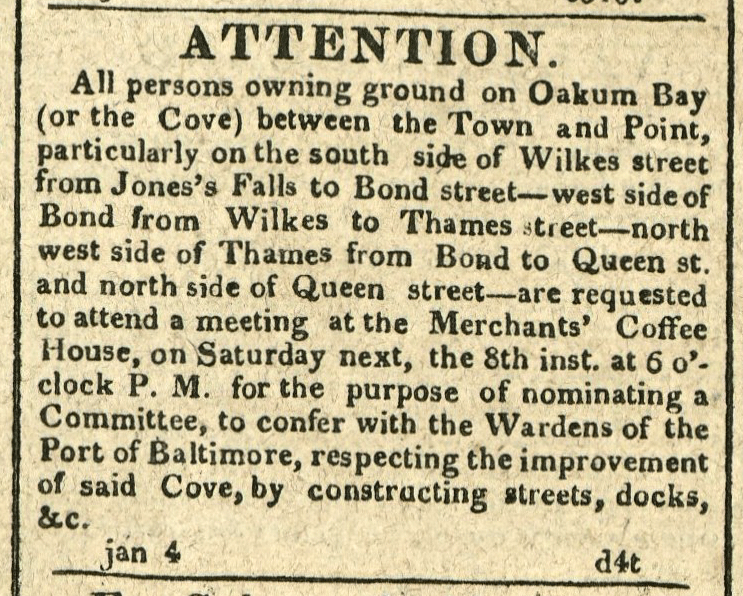8 – Fine day, went to Town, return’d to Dinner – Haul’d 24 Lods of Ice today with two Carts, which is very great work. – House nearly full.
From the journal of Captain Henry Thompson, January 8, 1814. Courtesy the Friends of Clifton.
8 – Fine day, went to Town, return’d to Dinner – Haul’d 24 Lods of Ice today with two Carts, which is very great work. – House nearly full.
From the journal of Captain Henry Thompson, January 8, 1814. Courtesy the Friends of Clifton.

On January 7, 1814, the United States Patent Office granted John H. Guiramand a patent for his new design for a power loom. Born in Lyon, France, John Guiramand, known as Jean Pierre Morel de Guiramand, moved to the French colony of Saint-Domingue. When the Haitian Revolution began in 1791, Guiramand joined hundreds of white French colonists in fleeing the island and moving to Southern American cities like Baltimore.
In 1814, Guiramand’s work was part of a wave of invention sweeping the growing American textile industry. Between 1810 and 1820 alone, the U.S. Patent Office recorded thirty-eight patents for power looms. First invented in 1784, the power loom connected traditional textile looms to water wheels (and later steam engines) to speed up the weaving process. Like many other American “inventors” in early 1800s, Guiramand may have closely copied his design on models already in use in France or England. In February 1814, Guiramand advertised the “New Invented & Patented Loom” in the American and Commercial Daily Advertister boasting:
“[Guiramand] has invented a loom, which although extremely simple possesses greater advantages than any heretofore known… A child 10 or 12 years old, may learn to use it in a couple of hours.”
Unfortunately, the exact nature his invention remains a bit obscure: the first 10,280 patents issued between 1790 and 1836 burned up in an 1836 fire and only around 2,800 of those lost have ever been recovered.
7th – Fine day, and having Frozen for a week past, commenc’d filling my Ice House, haul’d 21 loads today with two Carts from Herring Run Went to Town return’d to Dinner
From the journal of Captain Henry Thompson, January 7, 1814. Courtesy the Friends of Clifton.
On January 6, 1814, the United States Congress awarded Captain Oliver Hazard Perry and Captain Jesse D. Elliott the Congressional Gold Medal for their service at the Battle of Lake Erie on September 10, 1813.
On the same day, Lieutenant William Ward Burrows II and Lieutenant Edward McCall received a Congressional Gold Medals for their service in the capture of the HMS Boxer on September 5, 1813.
6 – Cloudy day – Wind SW – Cool – Went to Town, being much better, return’d Home to Dinner –
From the journal of Captain Henry Thompson, January 6, 1814. Courtesy the Friends of Clifton.
5th Jan. Snow last Night, it is about four Inches deep, clear’d up at 12 O’Clock with NW Wind – Staid at Home & took Medicine, better in the evening – Cold – another Lamb last night.
“4 – Very cold cloudy day. Wind NE – Went to Town return’d to Dinner, feel unwell from a Cold, and the Inocifalus [?] in my Face, which is very painful – another Lamb.”
From the journal of Captain Henry Thompson, January 4, 1814. Courtesy the Friends of Clifton.

In 1783, Maryland established the “Wardens of the Port of Baltimore” to oversee the construction of wharves, to help maintain clear waterways, and collect duties from vessels entering and leaving the Port. By the early 1800s, the marshy cove at the bottom of the Jones Falls — also known as Oakum Bay for the a tarred fiber “oakum” used in caulking and shipbuilding — posed a significant public health hazard. An 1808 report on the origins of Baltimore’s frequent yellow fever epidemics pointed a finger at the cove as a “sink of putrefaction,” continuing:
“So offensive were the effluvia emanating from this source of death that it affected those who had occasion to pass it even at a considerable distance interstices.”
The January 8, 1814 public meeting advertised in the American and Commercial Daily Advertiser helped to launch an effort to eliminate this hazard by filling in the cove and build the City Dock still located near today’s proposed Harbor Point development project.
“3 – Very fine day – Mrs. T accompanied me to Town, we return’d to dinner – Had a Lamb last Night & one today – John Conrad commenc’d trimming the Orchard at Furley, it is in very bad order & required much Pruning.”
From the journal of Captain Henry Thompson, January 3, 1814. Courtesy the Friends of Clifton.